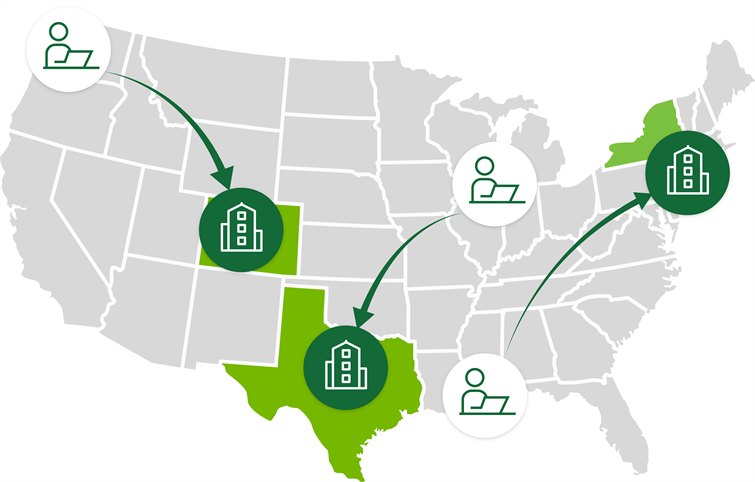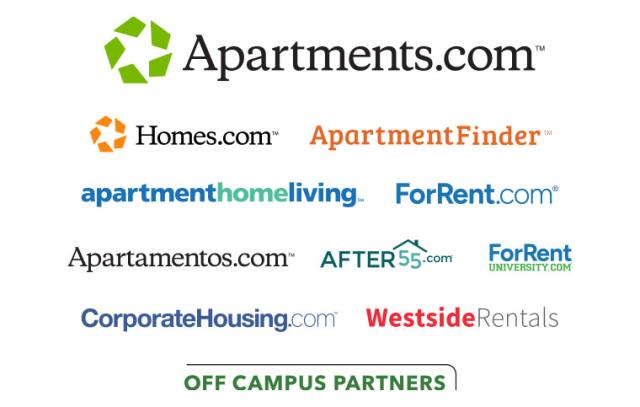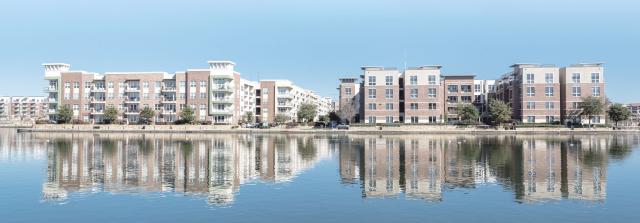
Apartment marketers are keeping a close eye on out-of-market searches, looking for trends and how to leverage them to attract prospective residents.
With several large markets stricken by COVID-19 effects such as employment, health concerns and urban unrest, the most mobile workers – namely those younger professionals and those without a spouse or children – are looking to make moves.
In June, Apartment.com Senior Director, SEO & Analytics Jordan Silton suggested an upward tick in these types of searches, pointing out that the 38 percent of such traffic in May was moving toward 39 percent or 40 percent in the following month. These data were part of his presentation during the Apartments.com LIVE Virtual Summer Showcase.
Mid-Atlantic region apartment operator LIVEBe has seen a 30 percent bump in out-of-market apartment searches in the past 45 days, especially from Chicago, says its Vice President, Elaine De Lude.
New York and California also are up considerably and Dallas and Pennsylvania also are trending slightly higher, she says.
“It’s hard to say exactly the reason why,” she says. “It’s just something that is sticking out when I look at the numbers.”
De Lude says out-of-market applications tend to take longer to process than local ones, so she doesn’t yet have the “full intel” on any out-of-staters who have applied. Therefore, she can’t pinpoint a direct reason for the spike.
“We are seeing that these applicants are younger and not married or with kids,” De Lude says. “They are more easily mobile, which would make sense. Are they just trying to get out of where they live? I think we’ll know more in about 30 days when we have more information.”
De Lude says of a spike in out-of-market searches, “If we are able to identify a group, we could change our messaging to appeal to it.” She says traveling nurses is one cohort that tends to move to the Washington, D.C., market and she will keep an eye on that category.
“If that’s the case, we would begin to emphasize how easy it is to move in,” she says. “Prospects like to hear that. We won’t really focus on our amenities – some of them might not be open due to Covid-19 – but we will use calming words. People never like to think about the hassle of moving.”
What makes this uptick more interesting is that competitor Gates Hudson, which focuses on the D.C. market, says 40 percent of its search traffic is out-of-market. “It’s been very consistent for us since employment leans heavily on government/education,” Shane Gillman, Director of Marketing, Gates Hudson, says.
Out-of-State Traffic Exceeds In-State
For Arizona-based apartment developer Optima, Inc., out of state search traffic is up along with signed leases from those coming from outside Arizona. From April through July, it has leased to more Californians, for example, than those in its home state.
“We have always seen significant out of market traffic across our Arizona portfolio, but this is the first time we’ve ever seen that trend,” David Hovey Jr., AIA, president and principal architect of Optima, Inc., says.
“We see people relocating from several markets for work as well as people who are relocating their companies to Arizona from California. There is also a large group of people who are now working remotely who are choosing to live in Arizona rather than California.”
Hovey says Optima has launched a specific campaign targeted toward Californians who may be interested in relocating to Arizona.
“We find they are attracted to our amenity and service offering as well as our location,” he says. “Our communities are located steps from the best shopping, dining, entertainment and the incredible leisure activities offered in Arizona.”
Not High on High-Rises
Virginia Love, Industry Principal, Entrata, says she’s read analysis pointing out that many are thinking, “If I work from home and can work anywhere, why do I live here" question. For example, living in San Francisco or New York City are highly desirable, but also very expensive.
Love mentioned a recent article in The Wall Street Journal that points out, “We are seeing a lot of searches across states, not just towns, and anticipate a great migration from large cities such as Atlanta or Chicago to smaller ones like Greenville, S.C., and Jacksonville, Fla., where quality of living is not compromised by cost of living.”
Love says, it's about watching trends, seeing prospects from specific cities coming into the space and capturing more.
“I have several good friends who live in NYC that have packed it up and moved in the middle of all this,” Love says. “High-rise buildings have all those [communal] amenity spaces and features such as elevators and gathering spots that can’t be used. Most apartments in cities like Chicago and New York don't have balconies. I would target the heck out of people living in high-rises and give them deals to move into garden-style communities.”
Tony Sousa is Regional Manager at Embrey Management Services based in San Antonio.
“[Resident migration] poses a very good question – and yes, in Texas, we are seeing an influx of interest from west and east coast’s market from those who want more space, less governmental control and perceived safety from riots, unrest, etc.,” Sousa says.
To the contrary, during this [second, ongoing] COVID wave, Texas has been seen as hot spot, and that has reduced traffic during the past 30 days. It is definitely something we are aware of and is affecting leasing activity.”
Livin’ for the City
Equity Residential’s Executive Vice President & Chief Operating Officer Michael L. Manelis said during the company’s Q2 earnings call, said, “[In our] urban cores of New York and San Francisco both have been running at 91 percent to 91.5 percent occupancy; the rates were bouncing around. We’d go a few weeks where we find that stability point, so our near-term outlook [is one of] consistency. We [saw] shifts in migration patterns, so we’re looking at forwarding addresses for those people who leave us.”
Manelis said in Q2, among his New York and San Francisco residents moving out who left forwarding addresses, the percent from New York who went out of market increased to 50 percent from 35 percent a year earlier. He said New Jersey was the No. 1 destination. For San Francisco, the increase wasn’t as pronounced, and the top destination for those in the Bay Area was a move south to Santa Clara County.
Equity ResideWe see people relocating from several marketsntial’s President and CEO Mark J. Parrell said during that call that he envisions younger professionals wanting to return to city life after spending extended and unexpected time living at home with their parents. He said his comment was based on first-hand, anecdotal observations.
“As the summer wanes, they will want to be back in their normal routines,” Parrell said. “It’s certainly not a bad thing, especially when cities are this deactivated to maybe be in some other remote location for those who can't afford are able to do so. But a good number of people [could be] very anxious to get out of mom and dad's house and go back to her life in one of the big cities.”
Recap compiled by Paul Bergeron, a freelance reporter and CoStar contributor, who covers apartment management.








